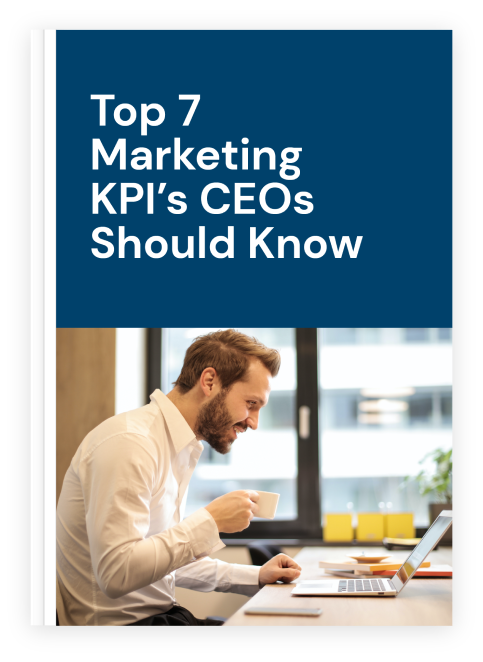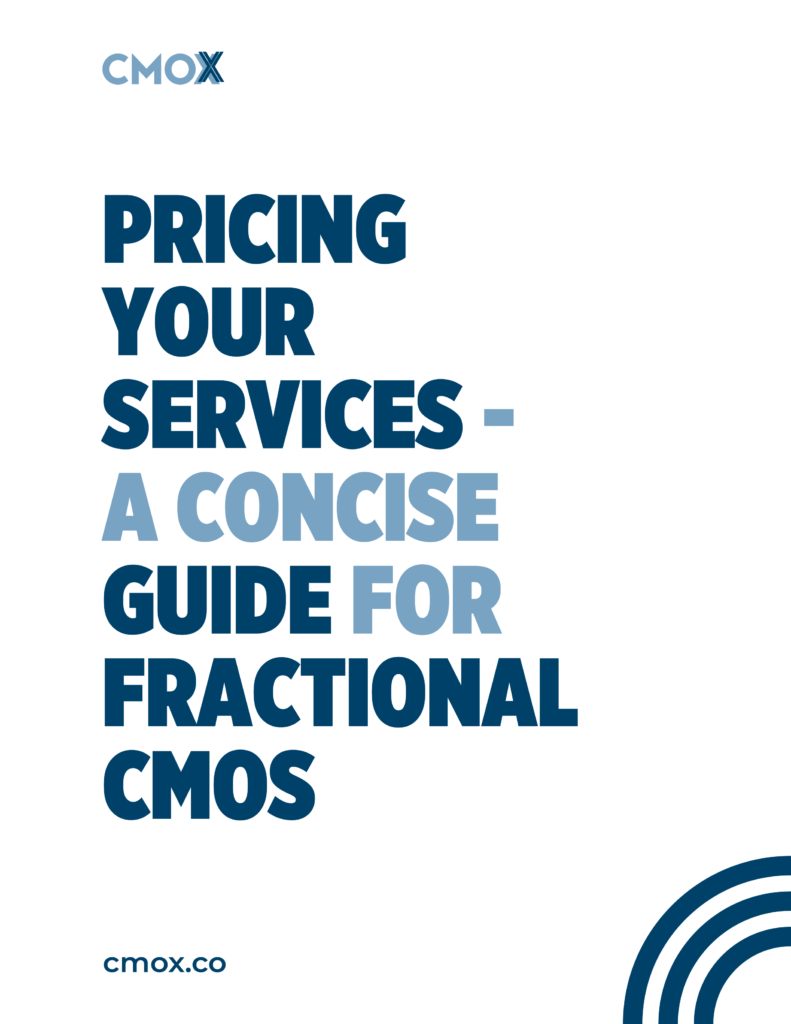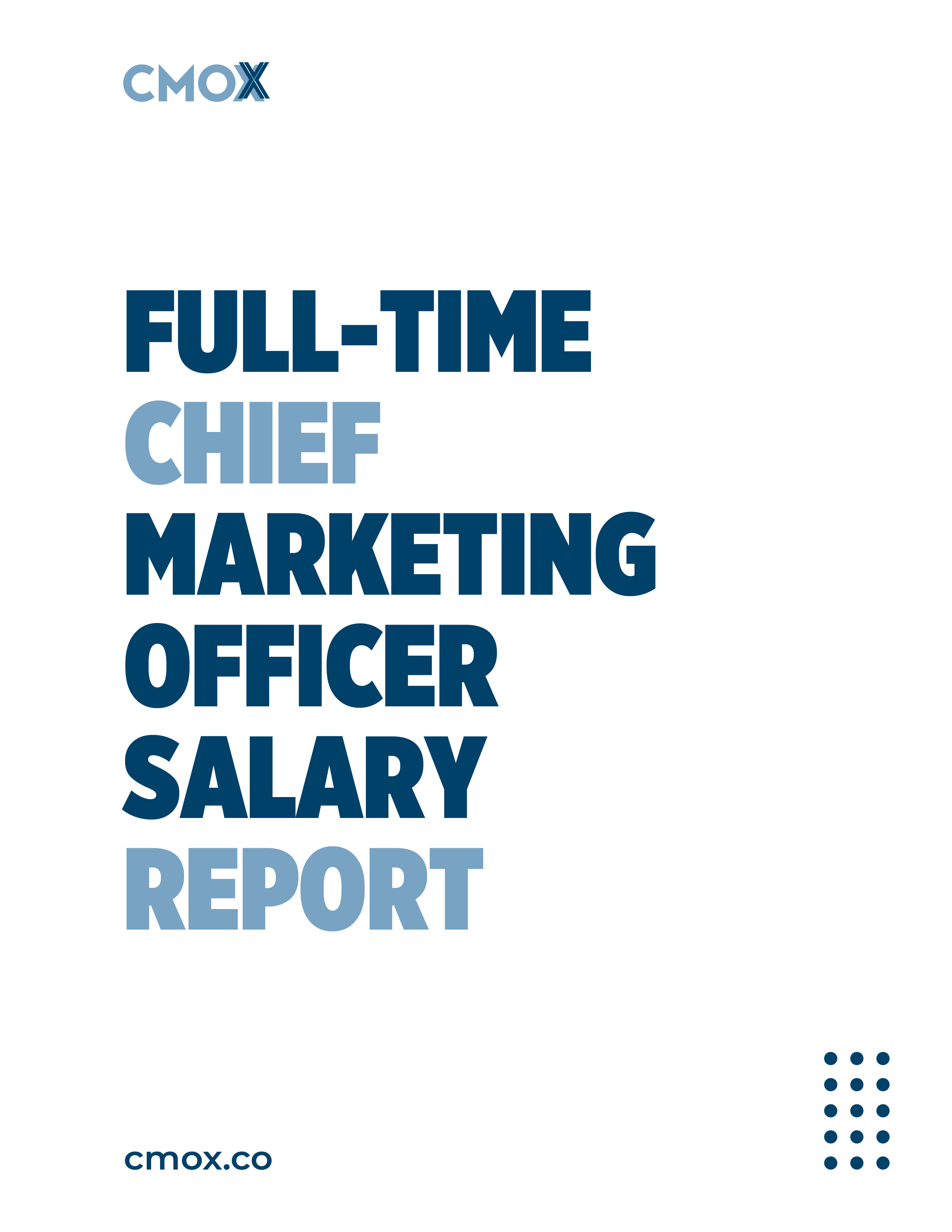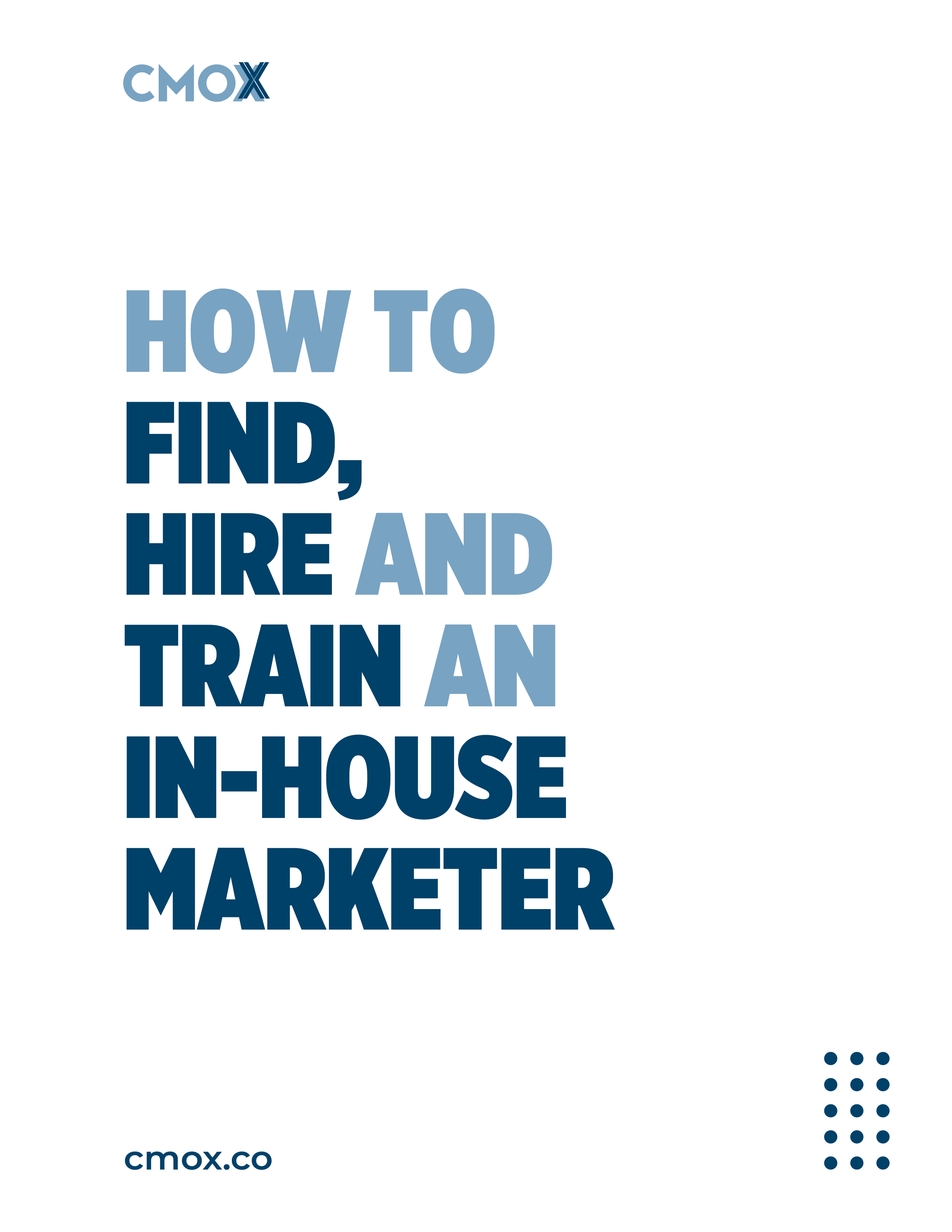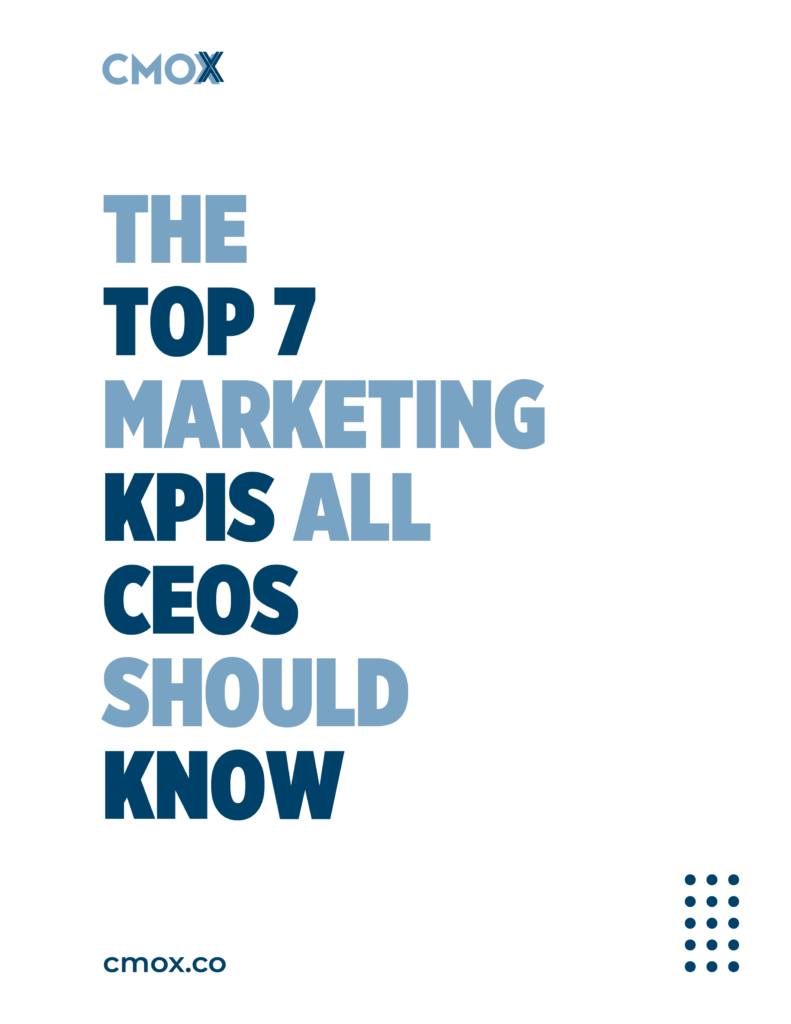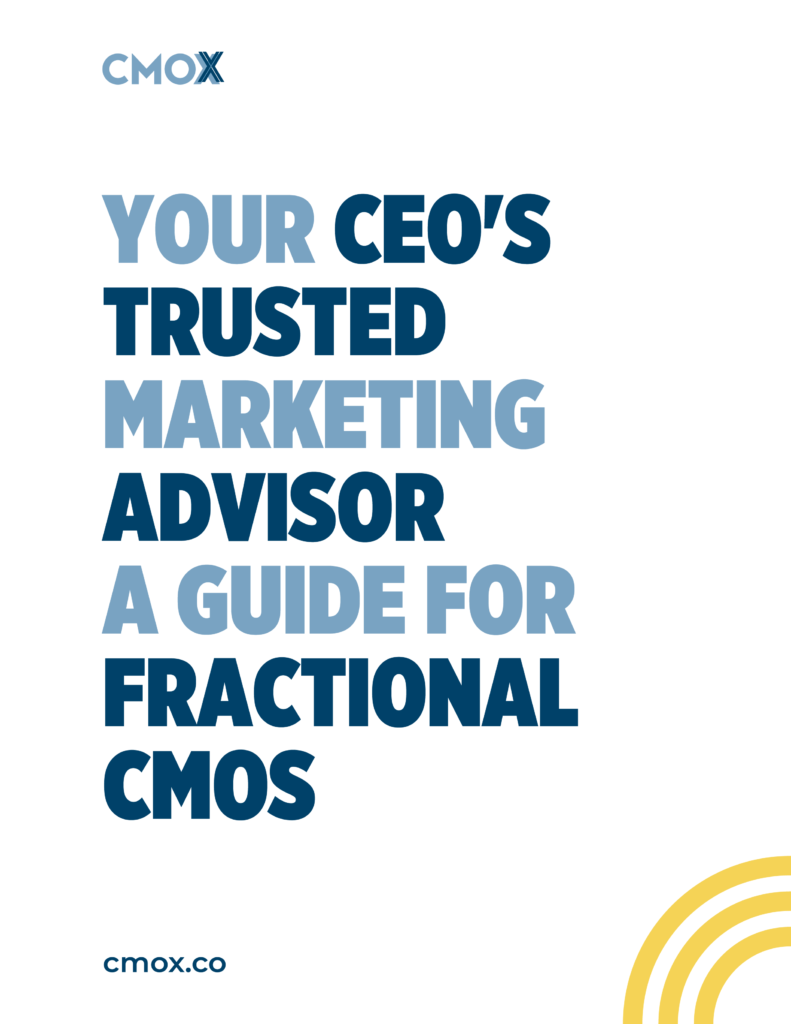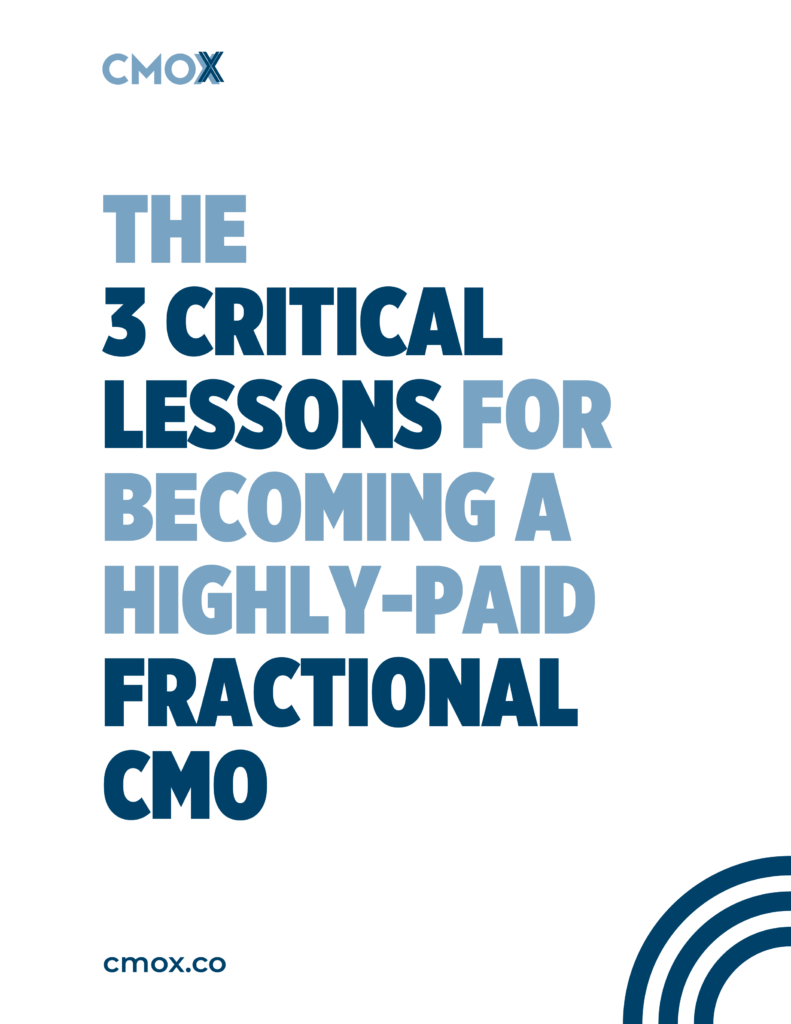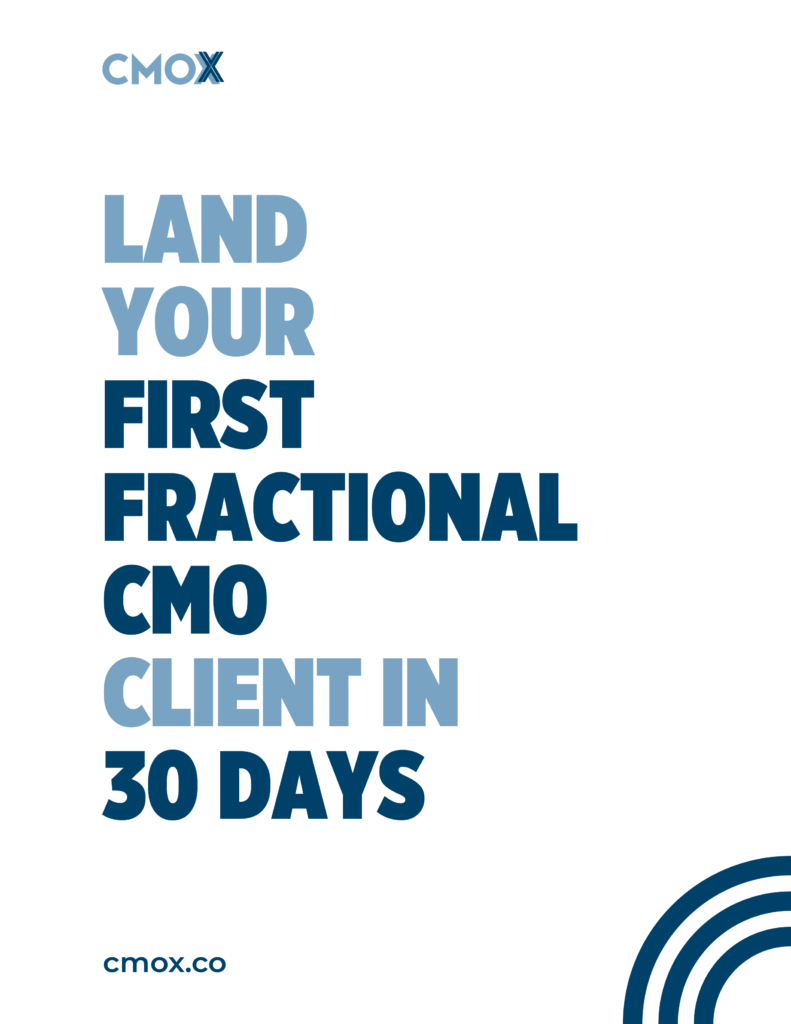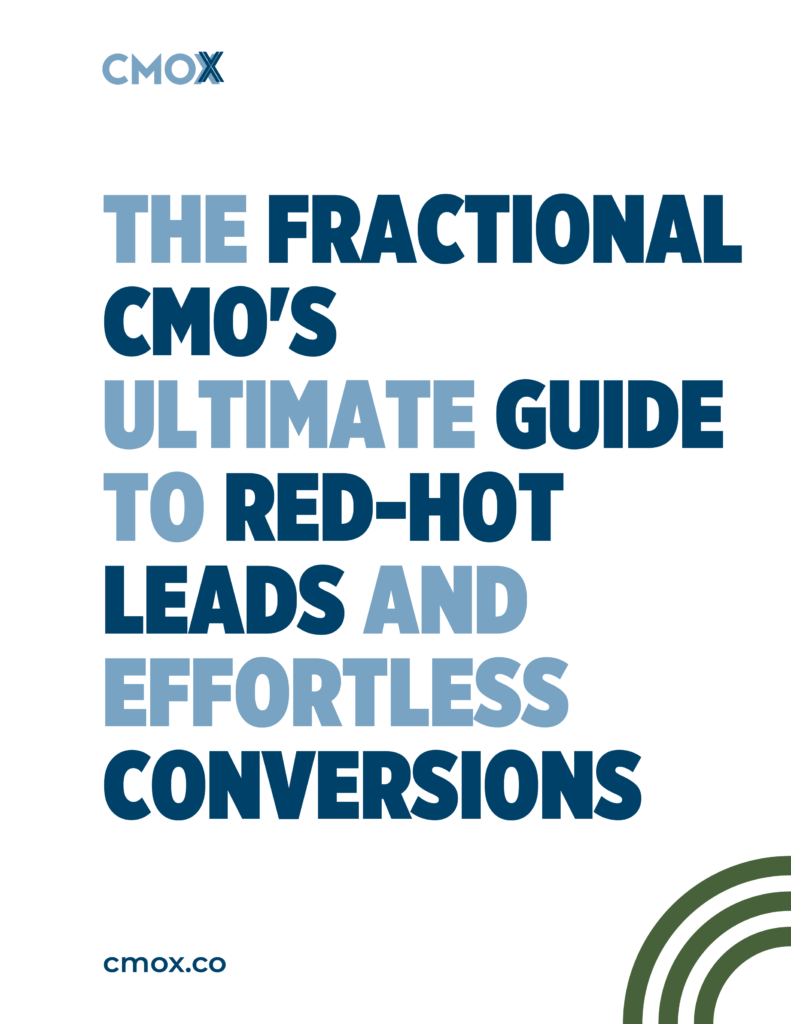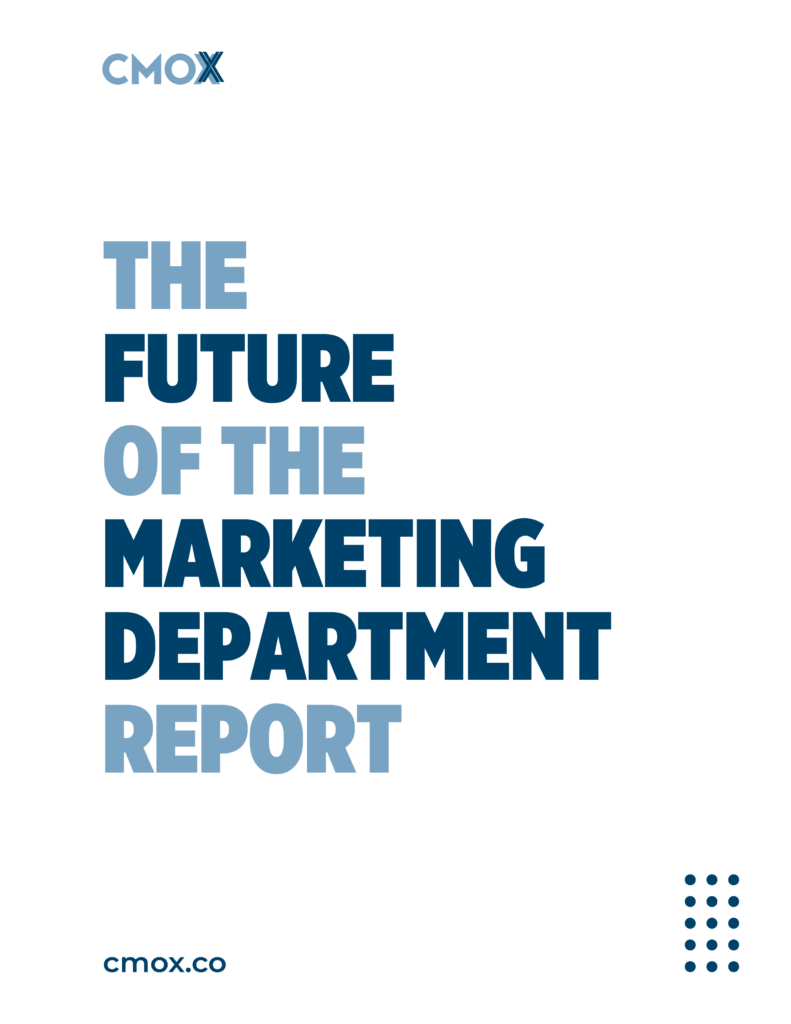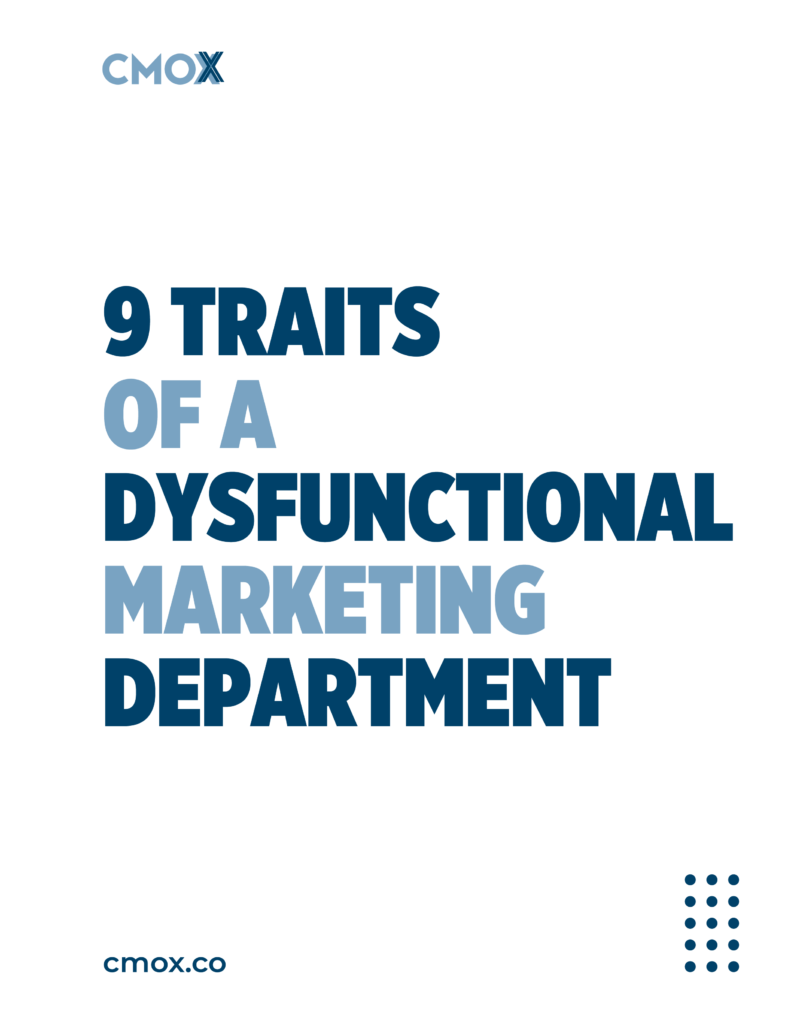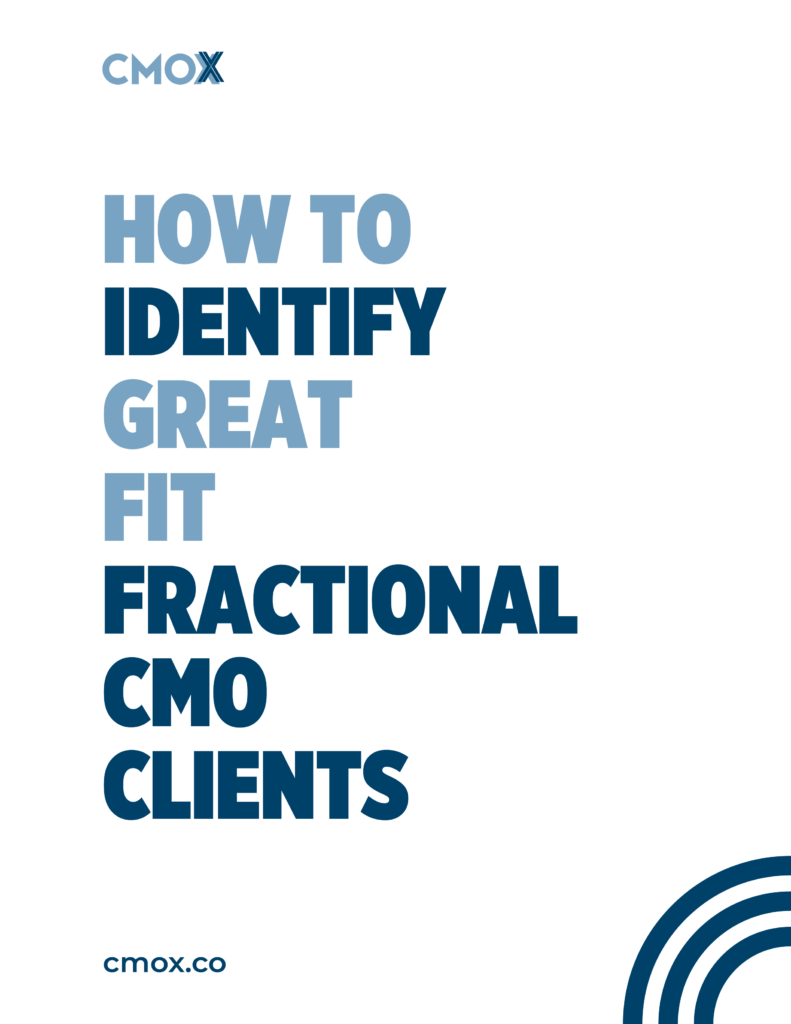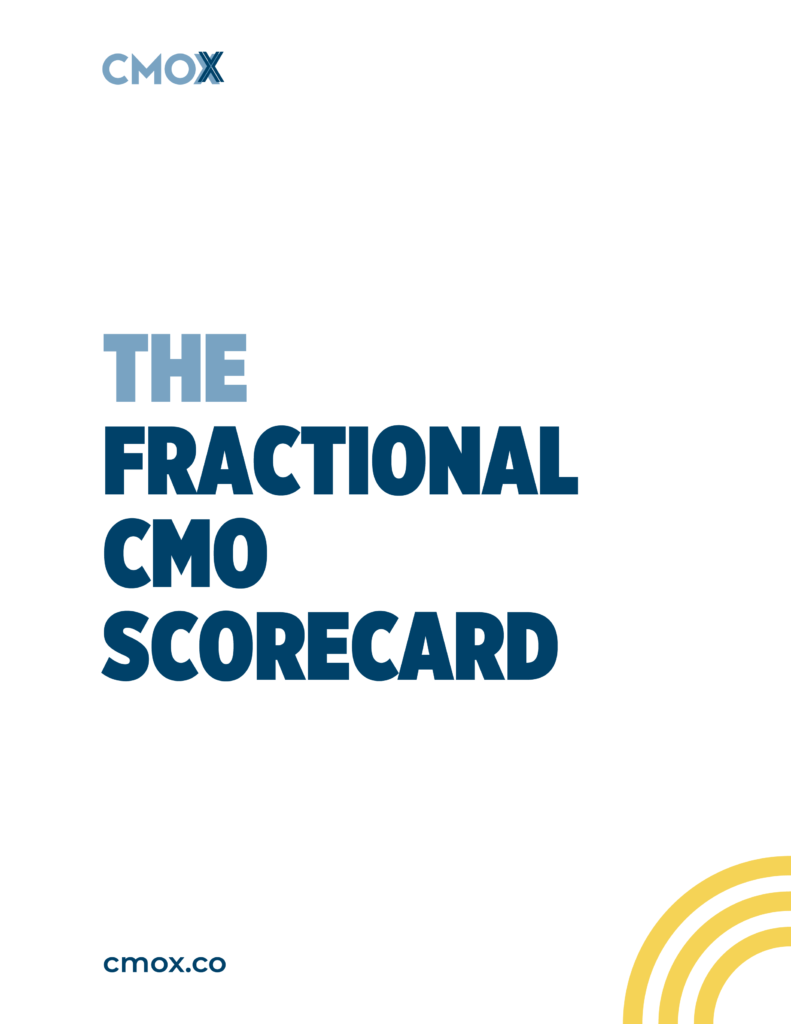Ep #89: Concreteness: Delivering world-class outcomes as a Fractional CMO (without being an expert in all the tools and platforms)

Struggling to stay ahead as a fractional CMO? Casey breaks down the power of concreteness—why understanding how things actually work makes you a stronger, more resilient marketing leader. Learn how to go beyond abstraction, delegate effectively, and solve bigger problems that drive real impact. From APIs and CRMs to building a high-value team, this episode is packed with insights to help you level up and lead with confidence.

Episode highlights:
Struggling to stay ahead as a fractional CMO? Casey breaks down the power of concreteness—why understanding how things actually work makes you a stronger, more resilient marketing leader. Learn how to go beyond abstraction, delegate effectively, and solve bigger problems that drive real impact. From APIs and CRMs to building a high-value team, this episode is packed with insights to help you level up and lead with confidence.
Here’s what we talked about:
- The importance of concreteness vs. abstraction
- Delegating everything except leadership
- How to spot-check technical work without being an expert
- Avoiding reliance on a single platform (e.g., HubSpot)
- Focusing on strategy, not execution
- Hiring the right people and holding them accountable
- Simplifying marketing for better results
Transcript:
00:00:00 Casey: In this episode, I’m gonna walk you through what concreteness means for the fractional CMO and how you can develop a skillset that will help you with all of your clients so that you can be anti-fragile, you can be a robust marketing leader, and no matter what the industry or what executive orders or whatever happens to the market, you will become un-muck-with-able. All right, let’s dive in.
00:00:27 Casey: Marketers of the world, why do we work hard to solve small problems? Why do we reinvent ourselves and our clients over and over? And why are we giving away marketing strategy for free? With advancements in AI, we’re all seeing the marketing department shrink from the bottom up. And companies need you to serve them as their fractional chief marketing officer. It’s time to solve bigger problems and bring home a bigger paycheck. It’s time to create the lifestyle we deserve and to make a greater impact.
00:00:59 Casey: This is the Fractional CMO Show, and I’m Casey Stanton. Join me as we explore this growing industry and learn to solve bigger problems as marketing leaders. The Fractional CMO Show is sponsored by CMOx, the number one company to teach you how to attract, convert, and serve high paying fractional CMO clients on your terms.
00:01:24 Casey: Hey, welcome back. So I wanna talk to you about this concept of concreteness. And I think it’s really important to understand this stuff fundamentally in life and also in marketing and also as being a CMO. I’ve pulled together some notes and I think that this is just like an interesting concept.
00:01:40 Casey: So what is abstraction? When we think of abstraction, I think of like abstraction in programming. For most people, they interact with their phones or their computer through the graphic user interface, the GUI, G-U-I, graphic user interface. This is the final layer of abstraction for folks. This is where they can see buttons, there’s text, there’s images, and there’s not code there. That’s where most people live.
00:02:05 Casey: And the problem with living exclusively in a place of this furthest level of abstraction is that you don’t understand how things work. The people that have set themselves up, I think poorly, are those that are HubSpot experts. And all they know is HubSpot, and they know where things are, but they don’t understand how it works. And therefore, when they go move to, they work with a different client and that client is on a different CRM, the person’s like, I don’t know how to use it. Like all I know how to use is HubSpot.
00:02:31 Casey: So then they pigeonhole themselves into the space of like only being able to work with HubSpot businesses. And I don’t want you to live there. I wanna teach you today how I actually don’t know how to use any CRM very well. Even the one in my own business. I don’t really even log in. Man, I can’t tell you the last time I logged into my CRM. And I’ll tell you why and why that’s not me asleep at the wheel, but actually a representation of me really understanding things in a deep way.
00:02:55 Casey: So when we think of the GUI, the web interface, what’s the layer behind that? Well, some of you have right clicked on your desktop or on the like Chrome browser or Firefox or whatever you use, hopefully not Edge. And you went to inspect source or view source or something like that. And you see the source code of the website. For a lot of people, that’s like eye-opening. That’s revolutionary.
00:03:16 Casey: I was going through a webpage today with one of my fractional CMO clients and I showed them a page that had a monday.com form with an iframe. So the iframe was embedded into a simple WordPress page. Like a very simple thing. You could set this up in like a minute and they were blown away by it. It’s like, how did you do that kind of complex thing? Well, it was like pretty simple. It’s just, you grab the iframe and you paste it in the code and publish it. What’s an iframe? Right? So like interesting.
00:03:40 Casey: If you don’t know what an iframe is, I really want to get you interested in what these things are. What’s an iframe ? It’s funny. I don’t even know what the definition of iframe is. Yeah, it’s an inline frame. That’s what the I stands for is inline frame, right? I’m still learning this stuff, but I know kind of what it looks like. An iframe is when a web page loads inside of a web page. That’s how I see it. Right? I kind of know when to use an iframe. You want to know kind of how to use an iframe too, as a CMO. Like that’s kind of an important thing.
00:04:06 Casey: Like you say, oh, I want to load this software inside of that software, how do I do it? So when we peel behind the curtains, we can start seeing the source code and it’s helpful. It used to be a lot easier before folks started using Google Tag Manager just to see the tags on a website. And even still, you can right click and view source on a webpage and see, do they have Google Analytics installed or do they have Google Tag Manager?
00:04:28 Casey: You might search for the letters UA as in Urchin Analytics, the first version of Google Analytics. You might look that up and see if Google Analytics is installed or you might do a GTM dash for Google Tag Manager to find their container ID. Those are just like simple tricks that you can use. And yeah, sure, you can like get a browser plugin that does that. And I’ve got one on my browser, it’s Google’s Tag Assistant. It’s a nice one in Chrome to be able to see if websites have certain pixels or tag managers or whatever installed. So that’s great to use.
00:04:56 Casey: But like you first have to know what it looks like. Like what is the Google Tag Manager code look like? And do you understand how to install it on a website? If you don’t, I really encourage you just to spin up a WordPress site and play with it. Go to kinsta.com and set up a, whatever it is, $10 a month WordPress hosting, buy a dot com and like start playing around with your own website. Not to build something beautiful because I feel like that’s kind of difficult, but just to play around and learn. Or do you like a sub domain from your site like test.caseystanton.com or something like that.
00:05:27 Casey: You just want to have a place that you’re playing. Like you’re always just kind of like interested in this stuff and just kind of seeing how it works. You want to know how to install Google Tag Manager. You want to know how to install Google Analytics. Like that’s pretty basic stuff as a marketer. I just think that you should be interested in understanding how that works. Not because you should ever be doing it as the CMO, but like you have to fundamentally understand how things work.
00:05:47 Casey: So what’s that layer behind the source code on the webpage? Well, if you think about it, the source code is really just the executed code and all you’re seeing is kind of the output of it. And then like a graphic user interface is derived from that. So that’s like the framework of the website or the application or whatever.
00:06:03 Casey: Also the API. Do you know what an API is? If you don’t, I really encourage you just to go for a walk with ChatGPT on the like the talking thing. Or you can just like walk and chat with it and have a conversation and be like, hey, I don’t know anything about APIs. What should I know about an API as a marketer, as a CMO? And you should know that APIs are ways for applications to interface with one another. That’s what it means, application interface. And you could get this piece of software to talk to that software.
00:06:29 Casey: APIs can revolutionize a business that don’t use them such that like the API feeds information from one tool to another tool without a human being in between it. That can be really nice. And maybe there’s a rule set that you devise and then the API has to go through some kind of like logic chain of saying like, if this lead is from this location, then put them in this bucket, into this CRM. And if it’s from this location, do this thing to them.
00:06:51 Casey: So APIs are really useful for stitching things together. You don’t have to know how APIs operate for all the different tools, but I want you to be the kind of person that can say like, hmm, this is like tricky. I see how you guys are doing this at the company. I’m wondering, is there an API solution that we can look at or some kind of automation that we can add? Like that’s the CMO level understanding that you need.
00:07:12 Casey: You say like, is there a way for us to kind of stitch this stuff together for this to work for us? I’m not really understanding like what’s working right now. Can we add an API in there? Is there anything like that that we can sign up for? And like in real time on these conversations, I say things like, hey guys, I don’t really know what the solution is, but I’m just gonna try some stuff on. So let me know if I’m going down the wrong rabbit hole, but I’m gonna open up ChatGPT and I’m gonna type in, does XYZ have an API? Yes, can I see the docs for it? And if I see the docs, that are usually published, you know, at docs.domain.com, typically places like that, we can see how the API is laid out and we can see here’s what you gotta know as a marketer.
00:07:47 Casey: Can we use the API to create new leads, update lead records, create opportunities in the CRM? That kind of stuff. If you can, then that’s maybe a utility that you wanna know that you have access to. So you have to understand that. You have to understand what APIs are and kind of how they work.
00:08:02 Casey: And then before that, what’s the level of abstraction before that? It’s like memory management, systems calls, that kind of stuff. This gets maybe a little unnecessary for you to know. I think it is helpful for you to know that like Python is a language that you could run locally. You can install Python on your Mac or PC or Linux device. And you can get Python to do scripty things like scrape web pages to pull lists and that kind of stuff. That’s a little nerdy. You probably don’t need to know that.
00:08:27 Casey: JavaScript, do you kind of need to know what JavaScript is? I don’t think so. Do you need to go to a low level programming understanding like C and Rust and that kind of stuff where there’s like direct interaction with memory and with hardware? Probably not. Do you need to learn assembly? No. Do you need to learn machine code and binary? No, certainly not. I think we can move past that level of abstraction of concreteness and move more to a level of abstraction. I just don’t want you existing on the seventh layer of abstraction exclusively.
00:08:56 Casey: You have to know how things work. So do you know what Zapier is? Do you know the classification of Zapier software? Like what bucket of software is that? It’s called middleware. Why? Because it’s in the middle of stuff. If I want one program to talk to another program and there’s no API for a direct application interface, I need Zapier in the middle, which chats between both. It zaps some information from one place to the other place. That’s Zapier.
00:09:21 Casey: And you should know with Zapier that it is kind of like the most expensive, but they’ve got a big motor around them because they have a ton of integrations with a bunch of stuff. So you can integrate HubSpot with text messaging, with your Gmail, with Google Sheets, with Twilio. Like, I mean, all sorts of stuff you can like integrate with Zapier. So Zapier is strong for that.
00:09:38 Casey: But there’s other tools like Zapier, like Make.com. That’s a great one. You could look at Make. You could play around with Make. I’ve got a buddy who built a very successful software business just based on a bunch of Make.com automations. Like he just created this integration with Make.com with a couple of front end websites. And that’s it. Like that was the core of his business. And then he brought in someone more technical and they built it out.
00:10:01 Casey: But he was able to piece together an MVP that was very valuable with just like clicking and building stuff like it was a flow chart. It’s what he did. It’s amazing to watch. And I watched him do it over the course of a year or two. And like now it’s off to the races and it’s a very successful business.
00:10:18 Casey: You gotta know this stuff because you gotta be able to spot check when a developer says something like, oh, I don’t know, Casey, that’s gonna take me two weeks to think about it. And then like, I’ll have to draw up this design document of all the stuff to do, and that’s gonna take me another two weeks, and yada, yada, yada. No. No way. No way.
00:10:32 Casey: I’m not gonna take months to figure the solution out. I’m gonna like come up with the use case for it and be able to deliver that to the tech person and say, quote this specifically. It’s just like a different conversation when you can start speaking their language a bit. And if you’re the kind of person who’s always been a creative marketer, like that’s still very valuable, but I want you to understand the concreteness of how things work because it’ll make your life better. It’ll make your life easier.
00:10:55 Casey: So at the beginning of this episode, I mentioned that I don’t know how to log into my- well, sorry, I know how to log in, but I don’t log into my CRM for CMOx. Like when was the last time I logged into ActiveCampaign? It’s a long time ago. I bet if I looked at the records, it was probably more than three months ago, maybe more than six months ago. I don’t need to be there every day. I just need to know what I want from it and I want those reports given to me.
00:11:18 Casey: So let me walk you through a couple of things. I’m into some hobbies. So if you’re watching this on YouTube, here’s one. I’m studying for the Ham Radio Extra Class. This is like the highest level license for ham radio. Why am I doing it? Honestly, because I’m just fascinated by electronics, how electricity works, you know, that kind of stuff. I’ve got a Morse code key on my desk and I play with this occasionally. So I key that up. Why do I do it? Because I’m interested, right? Because I’m interested in how things work.
00:11:43 Casey: I built this little QRP Labs, QMX radio. I don’t know, it took me 15 hours or so to build it. Soldered all the parts together. Ton of fun, learned a lot about toroids, capacitors, resistors, magnet wire, power delivery, buck converters. Just a bunch of stuff I never really would have learned about. And why? Because I just want to be connected to how things work, but I don’t have to live there. I don’t have to be the guy who’s like an electrician because that’s not my role in life. It’s to be a marketer, but I still want to know how things work.
00:12:12 Casey: Let me show you another example. This book, this book is a killer book. It’s a little dusty. Here it is. It’s Magnum Contact Sheets. What is Magnum Contact Sheets? It’s a big book. This is the contact sheets of Magnum photographers who are the top reportage photographers or documentary photographers. Why do I want to tell you about this? Well, they’re showing you the contact sheet.
00:12:32 Casey: The contact sheet is a full roll of film and they’re showing you how the photographer thought as they were taking the photographs. So you see an iconic photo and you’re like, wow, that photo is amazing. How did they get that one photo so perfect? And the answer is they didn’t get that photo perfect. They worked the scene. It took them a few minutes of kind of shooting and walking around to find a photo that they really liked.
00:12:52 Casey: Here’s an example of some photographs of Kennedy’s body on a train and everyone all around the country in 1968 saluting Robert F. Kennedy’s, or yeah, excuse me, Robert Kennedy’s funeral train procession. Obviously it wasn’t the one photograph that was taken. You could see on the right hand side here, all of the other photographs that were taken that same role, as you remember, like a film role might have 36 photographs on it, or if it was a medium format, it might have 12.
00:13:22 Casey: But still, right? It’s like, there’s a whole thought pattern to find the perfect one. As a photographer, I feel like I’m a hobbyist photographer, my job isn’t to like take one amazing photo, it’s to work a scene and make the best photograph of the scene I can. It’s about understanding how the photographer thinks, not just praying I’m lucky and spraying and praying, you know, a thousand photos every time I go out and then just culling through and trying to find one amazing one.
00:13:47 Casey: It’s just like working the scene and being more mindful and knowing how things work and the rule of thirds and where the leading lines are and where’s the subject. You know, is this more of an Elliott Erwitt style? Is this more of a decisive moment, Cartier-Bresson style? Is this more editorial, right? Like you wanna be able to understand the rules so that you can play by them and then ultimately break them if you choose.
00:14:07 Casey: In the business world, here’s a great book, Finite and Infinite Games. Great book, great book. You wanna get your head straight on what a finite game is and an infinite game is and like what game you’re playing. Another kind of concreteness enforcing book, Robert Greene’s The 48 Laws- excuse me, this is The Laws of Human Nature. Great book, The Laws of Human Nature. He also has The 48 Laws of Power, another great book. Those rules are gonna stay forever. Like you wanna learn that stuff.
00:14:34 Casey: So do I wanna know what’s working right now in TikTok? Part of me, the answer is like, yeah, I’m interested. Like if you know, tell me. But the other part of me is like, man, no, I don’t wanna know what’s working in TikTok. I wanna know who’s killing it in TikTok and I wanna hire them and I’ll pay them to tell me what they know or for them to do the thing or for them to train the team. But like, I don’t need to know what’s working. I don’t need to know inside of TikTok what to do because I can just zoom back out and say like, hey, let’s just think on a big picture. What’s going on? What’s the big idea in all of this?
00:15:04 Casey: I know marketing. I know how marketing works. I understand the customer journey. That’s why I always say that like, if I could choose one pedigree that someone comes from to be a CMO, I think the strongest pedigree is the copywriter because they just know everything about the person’s behavior. Like they know why people are buying. That mammalian part of their brain that isn’t very evolved, or excuse me, reptilian part of their brain that isn’t very evolved, that’s just like trying to get the thing, we want to tap into that with marketing. We want everything else to support us in getting there.
00:15:36 Casey: If you understand that, then you add to that like what good copy looks like. Not that you have to be a copywriter, but you have to know like, whoa, that’s good copy. Then, you know, the next level out like what it looks like when it’s designed well, when, when there’s a good customer experience, when the data is in the right places, on the right platforms, where the eyeballs are, but it all comes back to, is there something that you’re selling that people want and can you position in such a way that it helps them achieve one of their desires?
00:15:57 Casey: So if you know marketing, you can be very successful as a CMO, but a lot of people know the abstraction of marketing, like what’s working right now in Facebook. They say, hey, there’s this funnel. There’s this offer type. There’s this Shopify template that if I just applied it to a bunch of websites, it’s gonna make a bunch of money. And maybe that’s true, but if that’s your only trick is to understand like, this one thing that I have can be replicated for all these clients and I can make money. You’re gonna make money until that stops working and you’re not gonna know why it stopped working. And then you’re gonna find yourself in trouble.
00:16:30 Casey: So by being a marketer who understands how things work, you’re building up a base of understanding that supports you no matter what happens in the market. So there’s an executive order, right? Was that it or did Congress? Whatever. Just before Trump got in office, they banned TikTok for like 24 hours. What do you do? Like, what do you do if you’re the CMO? Well, you say like, okay, well, where else is traffic? Where else is there eyeballs? What’s gonna happen to all the eyeballs that were just like consuming all the TikTok traffic? Like, what’s gonna happen to all those eyeballs? Are they gonna go over to Facebook, over to Instagram, are they gonna go to Reels, are they gonna go to Threads?
00:17:00 Casey: Right, you’re like, you’re thinking through that and you’re making a plan based on that. And then you run that plan maybe by the media buyer who really knows those platforms inside and out. So again, you don’t have to be the person who knows everything about everything. You gotta be the person who can just relax into that authoritative role of understanding how things work. And then you let these people who are making their living, doing the tactic, do the tactic.
00:17:21 Casey: That’s why I’m happy to pay someone to do the tactic. Like all the time, I don’t run ads, right? For the company, for my clients, I don’t run ads. I have the ad people report to me their result. And only if things are bad, do I really wanna dig in. But if things are hitting our targets or exceeding our targets, I just let them cook. I give them space.
00:17:41 Casey: So again, this is how you can be the fractional CMO and delegate everything except leadership. I don’t delegate because I’m asleep at the wheel. I delegate because I pull smart people in, I trust them and I verify with data and I hold them to a standard. And if they achieve the standard, I’m thrilled. They don’t need me breathing down their neck. And if they don’t hit the standard, then I ask them why not. Maybe I drill in, I get a second opinion from somebody else. If they’re right, then I learned something like the market won’t stand a certain price or an offer or whatever. Okay. I’ll learn something. Or the other side is maybe the second opinion says I should give someone else a shot. And I do, and they work the first person out of the job. Like that could happen too.
00:18:18 Casey: So again, I don’t have to know how Facebook ads work today. Like how they work inside of the systems. Like that’s just, I’m just not there. You know, that’s not the role that I sit in. It’s a very important role. If you wanna be that person, do it. It’s a great place to be. It’s just not the fractional CMO.
00:18:32 Casey: So what about like CRMs? I’m working on a project and they’re in HubSpot. Man, I don’t know. I don’t know HubSpot very well. Feels kind of weird, right? I don’t know HubSpot, yet I’m leading a company that is using HubSpot. It’s like, yeah, but they know it and they have ChatGPT and someone else is responsible for like the care and feeding of HubSpot. So I have to be able to say like, hey, I want these reports and I want you to follow best practices.
00:18:54 Casey: And I can tell them what best practices are. When a lead comes in, it’s a lead. When salespeople talk to it, it becomes a opportunity. There’s different opportunity stages. I want to track UTM source medium campaign term and content. I want to be able to run reports on deals that were closed with a value greater than X amount of money, or the leads originated in less than 30 days from lead origination to sale. Like I know that stuff. I can say that stuff and say like, get me that. If they say I’m stuck and I don’t know what to do, I just say, did you ask ChatGPT?
00:19:21 Casey: Because I know what it looks like when it’s done right, but I don’t know how to do it, right? Like, you know what it looks like when a room is painted well. Do you know the best practices for trimming a room out with tape? I don’t. My wife seems to. She’s very good at it, but me, not so much.
00:19:34 Casey: Okay, so you gotta be focused on the things that matter the most as the CMO, and then delegate the responsibility of the outcomes to the other person. You gotta know the basics. You gotta understand how marketing works. You gotta be like obsessed with good marketing. And good marketing isn’t sexy marketing. Good marketing isn’t Kanye running a second commercial, two years in a row, shot from his iPhone for the Superbowl where he sells a bunch of stuff. Like that’s cool, that was certainly was novel.
00:20:02 Casey: That goes to tell you that like, it isn’t really video production that matters. It’s more about like the celebrity and kind of like, there was something about Kanye’s first video. Then a second video and like the pulling down the store and selling Nazi, a Nazi shirt. Like what was that? I don’t know. I don’t even know. So like, we shouldn’t use that as a case study. We shouldn’t even look at Kanye generally as a case study, unless you’re working with clients kind of at that level.
00:20:23 Casey: Like, what should we look at? We should look at like what’s working right now in the market and get smart people in and just test it. You have to know that you’re creating an efficient customer journey, that you’re not giving people too many options, you’re not taking them to that restaurant that sells Mexican food and Greek food at the same time, because then you’re like, hey, can I get a quesadilla? And they’re like, sure, would you like queso with it or feta? And you’re like, what? Right, you don’t wanna be giving people too many options because then they drown in decision fatigue. Your job as a CMO is to simplify everything.
00:20:57 Casey: I chatted with a guy recently who took a business from about a mil- what would it have been? Like 1.5 million a year to 15 million. And he did it in 12 months. So he went from like $100,000 a month to $1.2 million a month. And how did he do it? He said, oh, I just took all the stuff that we were doing. I simplified it. All the places people could go, to the quiz, to the downloads, to this, to that. And I just brought them all back to the one thing and we drove them on the one thing. Just beautiful simplicity.
00:21:25 Casey: We think as marketers, we have to add in all this complexity. They do 10X to business in 12 months with ads, obviously. He’s spent a lot of money on ads. Just by focusing all traffic to one offer. So incredibly simple. So like that’s your job is to find that level of simplicity, not to feel anxious or like a fraud or something, because you don’t know how HubSpot deduplicates leads, because you don’t know the right place to pull a report in ActiveCampaign.
00:21:53 Casey: I wanna be clear with you. Don’t hear this wrong. You are fully responsible for the success of the marketing department and you have a choice. Will you be successful in the marketing department because you’re bringing in smart people, giving them big objectives, supporting them, checking in with them, offering your help if they need it, but giving them space to do their magic. You wanna be that side or you wanna be on the other side, which is they give people short-sighted outcomes and you have to project manage like crazy and check in with them every day and you’re probably always feeling like they’re behind.
00:22:27 Casey: Like, which one do you want? I’m going to choose the one where I bring in adults and adults do adult things. And if they don’t work out, they don’t work out. And like, we kind of get it. We understand from like, hey, that didn’t work. You had the core to do it. You kept saying it was on track last day. You failed by a lot. Dude, I can’t trust you. You got to go. They’re like, I understand. Right. Like you can have that kind of relationship.
00:22:48 Casey: And maybe you’re saying, Casey, I’m working with people that aren’t that level of mature. How many US federal workers got laid off in the last few weeks? A ton. How many people from blue chip companies got laid off recently or will get laid off soon due to AI? A ton. Are you telling me that there isn’t someone that can do the job better than the person that you have right now? Because if you think that’s true, it’s probably a limiting belief or you don’t have processes in place that document what the person’s role is so that they can be replaced.
00:23:16 Casey: And I would just say, have them document everything now, like pause the episode after I finished the sentence and have, send an email out to them and say, hey, by Friday at 5 PM, I need a documentation for your five most common tasks that you do every week. And then the next week, have them do another five, the next week, another five. In a month, you have all of their outcomes that they do at any given month documented, and you have that. And now you just say like, are they the right person for the job? If they’re not, let me go find somebody else.
00:23:46 Casey: If you really have low trust in this person, get a job description live today or tomorrow. How can you do it so fast? Just go to Upwork or Indeed and find a good job post that someone else is running. Copy it, throw it to ChatGPT and say you rewrite this for my business hiring this. These are the things that are different, yada yada go. It’ll print it off. If you have to send it over to the CEO or whatever, do it. Where do you post it? Go to Indeed jobs. Best place to go. If you want to find folks overseas, Upwork is my favorite.
00:24:13 Casey: And just go find candidates and have them approach you and see then who’s better. The person, the incumbent, who you kind of have like second guessed for a while, or this new person who actually seems pretty solid and is the same rate or cheaper, right? I think you’ll make the decision pretty quickly on which way you want to go.
00:24:32 Casey: So all of this to say is like, do I think you should get into ham radio? Yes. Just because I want more people to talk to. And I would totally run a net where we can talk fractional CMO stuff if anyone wanted to get into that. But it’s probably not your interest. I just want you to understand how marketing works. That’s the big thing. I just want you to understand how humans buy, what a good buyer behavior is.
00:24:54 Casey: The stuff that I do as the CMO is honestly logical. And I just keep myself out of the stuff that doesn’t matter as much. Like, is it a first level problem or is it an abstraction? Like there’s the core problem, which is, guys, we’re selling stuff, but we have no recurring revenue from anything we sell. Can we ideate a product or service that has a recurring billing so we sell it once and people get charged for years? If you bring that one idea to one of your clients that sells a transactional item, that could just overnight transform the business and make revenues just a lot smoother. That would be huge. I want you there.
00:25:34 Casey: I don’t want you at, do I think that the logo looks good in the top left corner of the ad or in the bottom right corner? What do we think’s better? I don’t even wanna talk about that. If someone brings that up to me, just like how many other questions do we need to talk about first before we like earn the opportunity to talk about candy like that? Honestly, I would just say like, just test it, right? I don’t even have an opinion about that, you know, like logo placement on the app. Just like, just test it.
00:26:01 Casey: So that’s where you wanna be. Solve bigger problems and then delegate everything except leadership. Solve bigger problems, delegate everything except leadership. Again and again and again and again. And everyone is gonna try to pull you into small problems because they’re interesting, because they’re fun, because they’re newsworthy. Man, do they make money? Are they really the thing? It’s like people painting the bow of the boat while there’s a torpedo coming straight at the hull. Well, we should stop the torpedo or dodge it best we can and then repair any damage before we worry about painting the poop deck, okay?
00:26:33 Casey: I don’t think you have to know everything about every CRM. I don’t think if you work with a client and they say like, hey, we use HubSpot, are you a HubSpot expert? And you say, that’s a really great question. I understand how CRMs ought to work and I have a great understanding of best practices around that and I would not be your CRM technician, but I’ll make damn sure that the person that’s running the CRM is world-class at it. Right? That’s what I’m looking for.
00:27:00 Casey: I’m just looking for the right person in the right seat. I don’t have to be the everything person. I have to be the strategist and the leader. And if I choose just one, it’s leader. That’s what they’re looking for. Someone to drive things forward. Someone to help triage. Not someone who knows every single thing.
00:27:17 Casey: So don’t live in a world of abstraction. Find where you’re abstracted in your understanding of something and just dig one level deeper. Just one level deeper. And how do you do it? Just ask ChatGPT. Just ask that blue cloudy bubble on your walk and just open up the dialogue and just chat. Take questions like, how I wanna have a better understanding of how XYZ works. Tell me what this means. And just go back and forth, back and forth. And just understand a level just beyond where you are.
00:27:43 Casey: If you exist in a world of abstract, something’s gonna happen, and you’re just gonna get bamboozled. I started the episode by saying that this would make you anti-fragile, robust, and un-muck-with-able. So what does anti-fragile mean? Anti-fragile means something that improves when faced with stressors, uncertainty, or risk. For example, a sturdy structure that becomes stronger in bad weather. That’s anti-fragile. I want you to be anti-fragile.
00:28:14 Casey: When there’s stressors, I want you to get better. You don’t get better by learning every single nuance of every single thing, you fall back to the basics. I want you to be robust as a marketer, and I want you to be un-muck-with-able. All right? I don’t want anyone to be able to push you around because you don’t have to know how things work with a certain software, but you have to understand how the software generally works, how softwares interact with each other, how customers come in, how leads convert to customers in the flow, and that you’re prioritizing generation of MQLs, not in low quality leads, and that you’re looking at gestation from lead to sale. And like, if you’re focused there, you’re going to be a winner for the client. And if you’re focused on knowing all the details, you’re not.
00:28:56 Casey: I’ll leave you with this one thought, which is, I think, a little counterintuitive. By not knowing how HubSpot works, you can’t save the day. So you have to get other people around you to be able to save the day. If HubSpot, like there’s an issue, like who are you calling? Because the answer isn’t like, you’re gonna put on your glasses, roll up to your computer at night and work all night to fix it. You’re gonna call someone and say, I need this fixed by morning and they’ve gotta do it.
00:29:20 Casey: So by not knowing, like you’ve gotta find this line of not weaponizing your incompetence, but instead like using your incompetence in a way that’s effective to delegate the outcome to somebody else. Because again, and I’ll repeat, you are solely responsible for the outcomes of the marketing department. Every marketing thing is your fault. And if it’s good, you move out of the way and the team gets the praise. And if it’s bad, you take the blame and turn around to the team and build better processes with them, right?
00:29:48 Casey: You take all the blame and you let all the praise bypass you and go directly to the team. That’s what a leader does, okay? If you’re doing that, you have to have other people in position so that you’re not screwing things up. So that forces you, certainly it forces me and it forces folks inside the CMOx Accelerator to build a deeper bench of talent so they can serve their clients. That’s what you’re after. And again, all of these people are available on the market today, more so than ever before, eager to be hired, begging to be hired. They’re very hungry for work.
00:30:21 Casey: So we see AI, you know, come more and more online and into tools and things, we just need less and less people working in the business. So getting a good paying job is hard to come by these days. That’s why you as a fractional CMO, kind of get your pickings of who you want on the team. So only work with people that support you, protect your confidence and deliver world class outcomes.
00:30:41 Casey: All right. If you want my help building your fractional CMO practice, so that you can spend your time instead of learning how HubSpot, like every nuance to HubSpot and all the tabs and everything and the settings. Instead of doing that, if you wanna learn how to attract high paying clients that pay you at the start of the month and on time and do what you say and say please and thank you and then you can deliver world-class outcomes to them. Like if you wanna work with those kinds of people that are really nice and fun to work with and need you and have a core problem that you can solve.
00:31:09 Casey: And then you exist in this marketing world where you’re the fractional chief marketing officer and you get paid a monthly fee, again, on the first of the month, and then you work the whole month. You’re not chasing after payment. And then on top of that, you’re building the team and these people are doing the stuff that’s under your vision, and you’re not responsible for doing the copywriting or the funnel building or the emails or whatever. And instead you’re the leader and you don’t take your paycheck and peel off a third of it and give it to one contractor to throw it off to another contractor.
00:31:35 Casey: No, instead you keep it all because you’re this Chief Marketing Officer, and then those people are also hired by the company and they get paid directly from the company. You know, you don’t kind of go through you. It’s not like an arbitrage game, but you get paid just for your time and your strategy and leadership as a CMO. I’d love to help you. It’s what we do. Maybe you can tell I’m a little bit passionate about this stuff. I think it is the next evolution of marketing. It’s a huge deal, I think, to be a fractional CMO and serve companies because you get to do so much good to them.
00:32:06 Casey: If you want my help, just book a call in with my team. Go to cmox.com/call and just book in a call. Just book in a 15 minute call. You’ll talk with someone on my team. They’ll ask you a couple of questions, super low pressure, like no pressure, just seeing if we can even help you. And if we think we might be able to, we’ll invite you to another call with one of the folks on my team who’ve been with me for years. And you can ask them questions and they’ll ask you questions. And if it makes sense to join, then you’ll join. Okay, so it’s no hard pressure. And we really wanna see you successful if you join.
00:32:38 Casey: Not everyone’s invited in. If we don’t think you’ve got what it takes, we’ll let you know, kindly, but at least we’ll tell you, right? We’ll be honest with you. And if we do think you’ve got the experience, the commitment, the eagerness, the hunger, then we’ll invite you in. And if you want to join, we’d love to have you. And that’s it. It’s really simple. I’ve got like a great week packed of calls with our members. We’ve got some really fun stuff happening. So if you want to join, book that call, cmox.com/call. All right, I’ll see you soon. Bye.
00:33:06 Casey: Thank you for sticking around for the full episode. As you know, learners are earners, but you’ve gotta take action on what you heard today. For more information and show notes, visit fractionalcmoshow.com. If you’d like me to answer your questions on an upcoming episode, you can share your question at fractionalcmoshow.com. And last, please hit the like and subscribe button so that I know that this content is helpful to you. All right, go get them.
Join Our Community
We are excited to announce the Fractional CMO Community Facebook Group. This aims to be a place where Fractional CMOs or marketers considering becoming a Fractional CMO can connect and share ideas.
Locations CMOx® serves
- New York
- Philadelphia
- Los Angeles
- San Francisco
- Chicago
- Houston
- Dallas
- Austin
- Miami
- Atlanta
- Denver
- Boston
- San Diego
- Seattle
- Portland
- Minneapolis
- Milwaukee
- Detroit
- Phoenix
- Washington D.C.
- St. Louis
- Toronto
